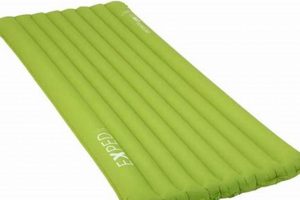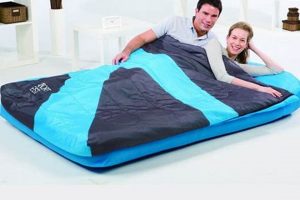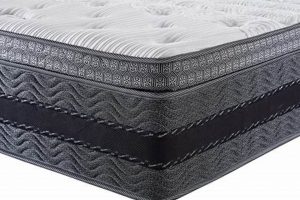The suitability of a sleep surface is contingent on an individual’s preferred sleeping positions. Combinations of side and stomach sleeping present unique support requirements, often necessitating a mattress that balances cushioning for pressure points along the side with adequate firmness to prevent spinal misalignment when lying prone.
Addressing the needs of individuals who alternate between side and stomach sleeping can enhance sleep quality and reduce the likelihood of musculoskeletal discomfort. Historically, mattress designs have often catered primarily to back sleepers; however, a growing awareness of positional sleep preferences has led to advancements in hybrid and adaptable mattress technologies. This adaptation is crucial for maintaining proper spinal alignment and minimizing pressure points, leading to more restful sleep and reduced morning aches.
The subsequent sections will delve into the specific mattress characteristics that best accommodate these combined sleep positions, including material composition, firmness levels, and construction techniques that promote both comfort and proper spinal support.
Guidance for Selecting a Suitable Sleep Surface
Selecting a mattress appropriate for both side and stomach sleeping requires careful consideration of several factors to ensure adequate support and comfort across varying positions. The following guidelines are intended to assist in making an informed decision.
Tip 1: Prioritize Medium-Firm Support. A medium-firm mattress generally offers a balance of cushioning for side sleeping pressure points and sufficient support to prevent excessive sinkage when stomach sleeping. This helps maintain spinal alignment regardless of position.
Tip 2: Consider Hybrid Construction. Mattresses combining innerspring coils with memory foam or latex layers can provide targeted support and contouring. The coils offer underlying firmness, while the comfort layers adapt to the body’s curves.
Tip 3: Evaluate Zoned Support Systems. Mattresses with zoned support feature varying levels of firmness across different areas. This design can provide enhanced support under the hips and torso for stomach sleepers, while still offering adequate give for the shoulders when side sleeping.
Tip 4: Examine Material Density and Resilience. Opt for materials with high density and resilience, particularly in foam layers. Higher density foams tend to be more durable and resist compression over time, maintaining consistent support.
Tip 5: Research Edge Support Capabilities. Strong edge support is beneficial for both sleeping positions, as it maximizes the usable sleep surface and prevents roll-off, particularly when sleeping near the edge of the mattress.
Tip 6: Consider Adjustable Bases. An adjustable base can allow for customized positioning to optimize comfort and spinal alignment in both sleeping positions. Slightly elevating the head or feet can reduce pressure on the spine.
Tip 7: Assess Temperature Regulation. Materials that promote airflow and dissipate heat can improve sleep comfort, especially for stomach sleepers who may experience increased body heat due to greater surface contact with the mattress. Look for features such as gel-infused memory foam or breathable coil systems.
Optimal sleep surface selection involves understanding the interplay between support, comfort, and individual body mechanics. By addressing these critical considerations, individuals can improve the likelihood of achieving restful sleep and minimizing potential discomfort associated with combined sleeping positions.
The following sections will explore specific mattress types and brands currently available that aim to cater to this combined sleep preference.
1. Medium-Firm Support
Medium-firm support represents a crucial component in the selection of a sleep surface designed to accommodate both side and stomach sleepers. Its importance stems from the divergent support requirements inherent in each sleeping position. Side sleeping necessitates a degree of surface compliance to alleviate pressure on the shoulders and hips, while stomach sleeping demands greater resistance to prevent excessive sinking of the midsection, which can lead to spinal misalignment. A mattress lacking sufficient firmness may cause the pelvis to dip too far below the shoulders in the stomach sleeping position, hyperextending the lumbar spine. Conversely, an overly firm mattress may fail to adequately contour to the body when on the side, resulting in pressure buildup and discomfort. Thus, medium-firm support seeks to achieve a balance, offering adequate give for side sleeping while still providing the necessary support for stomach sleeping.
The practical significance of understanding the relationship between medium-firm support and combined sleep positions is evident in the reduction of sleep-related discomfort and the promotion of spinal health. For example, an individual experiencing lower back pain might find that a mattress with medium-firm support allows them to sleep comfortably on their side without exacerbating pressure points, and also prevents their spine from sagging when they inevitably shift to their stomach. This is frequently achieved through a combination of supportive innerspring or coil systems paired with conforming comfort layers such as memory foam or latex. These materials work in concert to distribute weight evenly and minimize pressure concentrations, irrespective of sleeping position.
In summary, medium-firm support serves as a cornerstone in the quest for a suitable mattress for combined side and stomach sleepers. It attempts to mitigate the potential for spinal misalignment and pressure point development by providing a balanced level of support and cushioning. While individual preferences may vary, the principle of medium-firm support provides a solid foundation for selecting a sleep surface that promotes both comfort and proper spinal alignment across different sleeping positions.
2. Hybrid Construction
Hybrid construction represents a design approach integrating multiple material systems within a single mattress to address the diverse support and comfort requirements of combined side and stomach sleepers. The relevance of hybrid designs stems from the limitations of single-material mattresses in accommodating the distinct needs of each sleep position.
- Coil Systems for Support and Responsiveness
The core of a hybrid mattress typically involves an innerspring or pocketed coil system. These coil units provide foundational support, promoting spinal alignment, particularly for stomach sleepers who require resistance against excessive sinkage. The responsiveness of coils also facilitates ease of movement, accommodating shifts between side and stomach positions. An example includes a pocketed coil system that individually conforms to body contours while maintaining overall structural integrity.
- Foam Layers for Pressure Relief and Contouring
Hybrid mattresses incorporate foam layers, such as memory foam or latex, to offer pressure relief and contouring. These layers are strategically positioned above the coil system to cushion pressure points along the shoulders and hips during side sleeping. The density and firmness of the foam layers are critical, with medium-density foams often preferred to balance cushioning with support. For instance, a layer of high-density memory foam can effectively distribute weight and reduce pressure concentrations.
- Material Integration and Layering
The effectiveness of a hybrid mattress relies on the careful integration of coil and foam layers. The order and composition of these layers influence the overall feel and performance of the mattress. A common configuration involves a coil system topped with a transition layer of firmer foam, followed by a comfort layer of softer foam. This arrangement aims to provide both support and pressure relief. An improperly constructed hybrid mattress, with inadequate transition layers, may result in a disjointed feel or premature sagging.
- Edge Support Enhancement
Hybrid designs often incorporate enhanced edge support to maximize the usable sleep surface and prevent roll-off. Reinforced edges, typically achieved through the use of high-density foam encasements or additional coil rows, are beneficial for both side and stomach sleepers. Strong edge support allows individuals to utilize the entire mattress surface, even when sleeping near the edge. The absence of adequate edge support can lead to a feeling of instability and reduced sleep space.
Hybrid construction aims to synthesize the benefits of various materials, offering a balanced solution for those who alternate between side and stomach sleeping. The success of a hybrid mattress depends on the quality of materials used, the precision of its construction, and its ability to address the specific support and comfort needs of individuals who prioritize both pressure relief and spinal alignment across multiple sleep positions.
3. Zoned Support
Zoned support constitutes a strategically engineered mattress design aimed at accommodating the varying pressure and support requirements inherent in different areas of the human body. Its relevance to achieving optimal sleep quality, especially for individuals who transition between side and stomach sleeping positions, is significant. This design intends to maintain proper spinal alignment and distribute weight effectively, irrespective of the sleep position adopted.
- Targeted Lumbar Support
The lumbar region often requires enhanced support to prevent excessive sinking when stomach sleeping. Zoned support systems typically incorporate firmer materials in this area, which can help maintain the natural curvature of the spine and reduce the risk of lower back pain. An example includes mattresses with reinforced coil systems or higher-density foam in the central third of the mattress. This targeted support prevents the midsection from sagging, thus minimizing spinal strain.
- Shoulder and Hip Pressure Relief
Side sleeping concentrates pressure on the shoulders and hips, necessitating a degree of cushioning to alleviate discomfort. Zoned support systems often utilize softer materials or specialized cutouts in these areas to allow for greater compression and conformity. A mattress incorporating zoned support might feature a softer foam layer in the shoulder region, enabling it to sink slightly and maintain spinal alignment when lying on the side. The absence of this targeted pressure relief can lead to restricted circulation and discomfort.
- Transitional Support Zones
The transition between zones with differing levels of firmness is crucial for maintaining a seamless and comfortable sleep experience. Abrupt changes in support can create pressure points and disrupt sleep. Well-designed zoned support systems incorporate gradual transitions to ensure a smooth and uniform feel across the entire mattress surface. An example is a mattress that uses a gradient of foam densities to blend the firmer lumbar support with the softer shoulder and hip zones.
- Customization and Adaptability
The effectiveness of zoned support can be further enhanced through customization options that allow individuals to adjust the firmness levels in different areas of the mattress. This adaptability is particularly beneficial for individuals with unique body shapes or specific pain points. An adjustable zoned support system could allow a user to increase the firmness in the lumbar region while softening the shoulder zone. Such customization ensures that the mattress effectively addresses individual needs and preferences.
The integration of strategically designed support zones represents a significant advancement in mattress technology, specifically aimed at accommodating the unique needs of combined side and stomach sleepers. By addressing the pressure and support requirements of different body regions, zoned support systems can enhance sleep quality, reduce discomfort, and promote long-term spinal health. Their adaptability and customization options further contribute to their value in addressing individual sleep preferences and needs.
4. Material Density
Material density plays a critical role in determining the performance and longevity of mattresses, particularly for individuals who alternate between side and stomach sleeping positions. Density directly influences a mattress’s ability to provide consistent support, resist compression, and maintain its structural integrity over time.
- Support and Spinal Alignment
Higher density materials, such as high-density memory foam or latex, offer greater resistance to compression and provide more consistent support for the spine. This is particularly important for stomach sleepers, who require sufficient firmness to prevent excessive sinking of the midsection. Mattresses with low-density materials may compress quickly, leading to spinal misalignment and discomfort. For instance, a high-density foam core can ensure the spine remains properly aligned regardless of sleeping position.
- Pressure Relief and Contouring
While firmness is important for support, materials must also contour to the body to relieve pressure points, especially for side sleepers. High-density foams can distribute weight more evenly, reducing pressure on the shoulders and hips. In contrast, low-density foams may not provide adequate contouring, resulting in localized pressure and discomfort. An example is a high-density memory foam layer that conforms to the body’s curves, alleviating pressure and promoting circulation.
- Durability and Longevity
Mattress durability is directly correlated with material density. High-density materials resist compression and deformation, extending the lifespan of the mattress. Low-density materials tend to break down more quickly, leading to sagging and reduced support. Consider two mattresses, one with high-density foam and one with low-density foam; the high-density mattress will likely maintain its shape and support for a longer period.
- Temperature Regulation
Material density also influences temperature regulation. High-density foams can trap heat, while low-density foams tend to be more breathable. This is especially pertinent for stomach sleepers who have more body surface in contact with the mattress. Manufacturers often address this by incorporating cooling technologies, such as gel infusions or open-cell structures, in high-density materials. A mattress with high-density memory foam and gel infusion seeks to balance support with temperature control.
Ultimately, the choice of material density in a mattress intended for side and stomach sleepers involves balancing support, pressure relief, durability, and temperature regulation. High-density materials generally offer greater support and longevity, but may require enhanced cooling features to maintain comfort. Understanding the interplay between these factors is essential for selecting a mattress that promotes both spinal health and restful sleep.
5. Edge Support
Edge support refers to the reinforcement of a mattress’s perimeter to provide stability and prevent collapse along its edges. This feature is particularly relevant for individuals who sleep near the edge of the mattress, or for those who utilize the edge for sitting or support when getting in and out of bed. For individuals who combine side and stomach sleeping positions, edge support contributes to a more consistent and usable sleep surface, mitigating the risk of roll-off and ensuring uniform support regardless of proximity to the center or edge of the mattress. A mattress lacking adequate edge support may exhibit significant compression and instability near its perimeter, leading to uneven weight distribution and potential discomfort.
The connection between edge support and the suitability of a mattress for combined sleep positions lies in its capacity to maintain consistent spinal alignment and prevent positional restrictions. For example, a side sleeper positioned near the edge of a mattress with weak edge support may experience a tilting or sagging effect, which can compromise spinal alignment and induce pressure points. Similarly, a stomach sleeper utilizing the edge may encounter insufficient support, leading to pelvic sinking and lower back strain. Mattresses employing reinforced coils, high-density foam encasements, or perimeter wire supports provide a more stable and reliable edge, allowing individuals to fully utilize the mattress surface in any sleeping position. The practical impact of effective edge support translates to a larger usable sleep area, reduced risk of injury during ingress and egress, and improved overall comfort.
In summary, edge support is a critical factor in the overall performance and suitability of a mattress for combined side and stomach sleepers. By providing a stable and consistent sleep surface across its entire area, adequate edge support promotes proper spinal alignment, prevents positional restrictions, and enhances the overall sleep experience. Deficiencies in edge support can negate the benefits of otherwise supportive mattress components, emphasizing its importance in the context of achieving optimal comfort and health.
6. Temperature Regulation
Temperature regulation within a sleep surface significantly impacts overall comfort, particularly for individuals who alternate between side and stomach sleeping positions. Variations in body contact and surface area exposure associated with these positions necessitate careful consideration of mattress materials and construction to maintain a thermoneutral sleep environment.
- Material Breathability and Airflow
Mattress materials with enhanced breathability and airflow facilitate heat dissipation, preventing overheating during sleep. Open-cell foam structures and natural fibers like cotton and wool promote air circulation, reducing heat retention. For example, a latex mattress with pinhole ventilation allows for greater airflow compared to a dense memory foam mattress, mitigating heat buildup for stomach sleepers who have increased surface contact with the bed. Improper airflow can lead to discomfort and disrupted sleep patterns.
- Moisture Wicking Properties
Materials with moisture-wicking properties can absorb and evaporate perspiration, maintaining a dry and comfortable sleep surface. This is particularly relevant for individuals prone to night sweats or those living in humid climates. For instance, a mattress cover made of bamboo or Tencel can effectively wick away moisture, preventing a clammy sensation. This feature is beneficial for both side and stomach sleepers, as it helps regulate skin temperature and prevents overheating.
- Cooling Technologies and Infusions
The integration of cooling technologies, such as gel infusions or phase-change materials, aims to regulate temperature by absorbing and releasing heat. Gel-infused memory foam, for example, dissipates heat more effectively than traditional memory foam, preventing heat accumulation and promoting a cooler sleep surface. These technologies are especially valuable for stomach sleepers, as they tend to experience increased body heat due to greater surface contact with the mattress. A mattress lacking cooling technologies may lead to overheating and discomfort for stomach sleepers.
- Mattress Construction and Layering
Mattress construction techniques, including the arrangement and layering of materials, influence temperature regulation. Hybrid mattresses that combine coil systems with breathable comfort layers promote airflow and prevent heat retention. The layering of materials with varying thermal properties can create a more balanced sleep environment. For example, a mattress with a breathable coil system topped with a layer of open-cell latex can effectively dissipate heat and maintain a comfortable temperature. Poor mattress construction can impede airflow, leading to heat buildup and discomfort.
The interplay between material selection, construction techniques, and cooling technologies directly influences the suitability of a mattress for combined side and stomach sleepers. Effective temperature regulation promotes restful sleep by preventing overheating and maintaining a comfortable sleep environment, regardless of the sleep position adopted.
Frequently Asked Questions
This section addresses common inquiries and misconceptions regarding mattress selection for individuals who alternate between side and stomach sleeping positions. The information provided aims to offer clarity and informed guidance.
Question 1: Is a single mattress capable of adequately supporting both side and stomach sleeping positions?
While individual preferences vary, mattresses with medium-firm support and hybrid construction that combine coil systems with responsive foam layers often provide a balanced solution for accommodating both sleep positions. Individual comfort may be further enhanced with adjustable bases.
Question 2: What firmness level is most appropriate for combined side and stomach sleeping?
A medium-firm mattress is generally recommended. This firmness level offers sufficient cushioning for side sleeping pressure points while providing the necessary support to prevent excessive sinkage when sleeping on the stomach, maintaining spinal alignment.
Question 3: How important is edge support for individuals who switch between side and stomach positions?
Strong edge support is beneficial as it maximizes the usable sleep surface, prevents roll-off, and provides consistent support, especially when sleeping near the edge of the mattress. This is particularly useful for those who shift frequently during the night.
Question 4: Are there specific materials that should be avoided when selecting a mattress for combined sleep positions?
Mattresses constructed solely from low-density foams may lack sufficient support and durability, potentially leading to premature sagging and spinal misalignment. Similarly, mattresses with overly soft comfort layers may not provide adequate support for stomach sleeping.
Question 5: How does temperature regulation factor into the suitability of a mattress for combined side and stomach sleeping?
Effective temperature regulation is crucial, particularly for stomach sleepers, as they have greater body surface contact with the mattress. Materials with breathability and cooling technologies can prevent overheating and promote a more comfortable sleep environment.
Question 6: Can an adjustable base compensate for an inadequately supportive mattress in combined sleep positions?
An adjustable base can enhance comfort and spinal alignment by allowing for customized positioning. However, it cannot fully compensate for a mattress that lacks fundamental support and appropriate firmness for both side and stomach sleeping.
Selecting a suitable sleep surface involves understanding the interplay between support, comfort, and individual body mechanics. Prioritizing these considerations can improve the likelihood of restful sleep and minimizing potential discomfort.
The subsequent section offers a concise summary of the key considerations discussed in this article.
Conclusion
The preceding exploration of considerations relevant to the selection of a “best mattress for side and stomach sleeper” underscores the significance of balanced support and targeted pressure relief. Hybrid construction, medium-firmness, and zoned support are key attributes that facilitate spinal alignment and overall comfort across varied sleep positions. Material density and effective temperature regulation are also important determinants of long-term suitability and sleep quality.
The information conveyed herein is intended to serve as a foundation for informed decision-making. Further investigation, coupled with individual trials, is recommended to identify the sleep surface that most effectively addresses specific physiological needs and preferences. The investment in a strategically chosen mattress is an investment in long-term musculoskeletal health and restorative sleep.





![Best Semi Truck Sleeper Mattress [Guide + Reviews] Organic & Natural Mattress Buyer’s Guide: Non-Toxic Sleep Solutions Best Semi Truck Sleeper Mattress [Guide + Reviews] | Organic & Natural Mattress Buyer’s Guide: Non-Toxic Sleep Solutions](https://mattressworldpa.com/wp-content/uploads/2025/07/th-1748-300x200.jpg)

